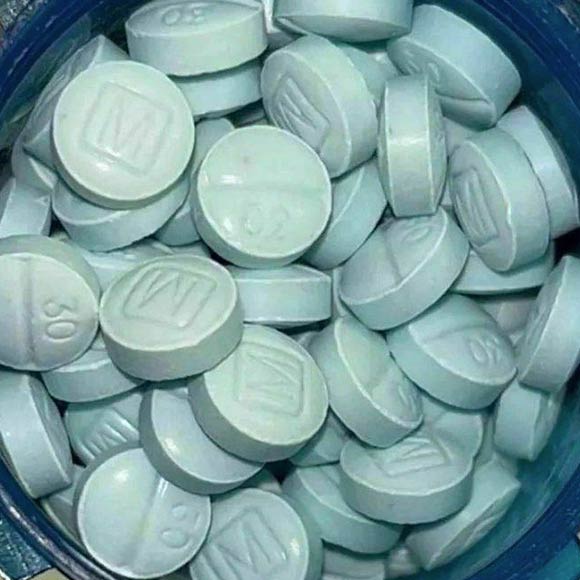Blues drug, also known as M30s, have become a growing concern due to their potency and their association with opioid abuse and overdose deaths. These small, blue pills are often sold on the streets as prescription opioids like oxycodone or hydrocodone. However, they are actually counterfeit pills containing fentanyl. Even in small doses, fentanyl can be deadly.
The presence of counterfeit opioid pills and non-pharmaceutical fentanyl (NPF) contributes to the worsening crisis of fatal overdoses in the USA. The Drug Enforcement Administration (DEA) has stated that illicit fentanyl is primarily responsible for the ongoing opioid crisis in the nation. The prevalence of blues drugs and counterfeit opioids emphasizes the urgent need for effective measures to address this alarming situation and prevent further harm to individuals affected by opioid abuse.
Other Street Names for Blues
Oxycodone pills are often referred to as blues roxies, but you may also hear as blues drug slang:
- 30s
- 40s
- 512s
- Beans
- Blues
- Buttons
- Cotton
- Greens
- Hillbilly Heroin
- Kickers
- Killers
- Muchachas
- Mujeres
- OC
- Oxy
- Oxy 80s
- Roxy
- Roxy Shorts
- Whites
- M30 pill
Street names pose a risk by potentially creating a false sense of safety, disconnecting the substance being used from its actual identity. For instance, if someone is offered blues by a friend, they may not realize that they are about to ingest a potent prescription opioid.
What is Blues Drug?
Blues drugs are counterfeit opioid pills that pose a significant threat as they contain fentanyl, a highly potent synthetic opioid. Aptly named blues due to their color, these pills are also referred to as “M30s” because of the distinctive markings with an “M” stamped on one side and “30” on the other. Although commonly found in blue, these counterfeit oxycodone pills can come in various colors such as red, orange, or yellow. When brightly colored, they are known as “rainbow” fentanyl. The concern surrounding their color stems from the risk of accidental ingestion, with the potential for children mistaking them for vitamins, other medications, or even candy.
What is Percocet 30?
Percocet is a prescription medication that combines oxycodone, an opioid painkiller, with acetaminophen, a non-opioid pain reliever. The “30” in Percocet 30 indicates the dosage of oxycodone in milligrams. This drug is typically prescribed to manage moderate to severe pain, often after surgery or for chronic conditions. However, its effectiveness in pain relief is coupled with a high potential for addiction and abuse. The opioid component of Percocet can create a sense of euphoria, leading to misuse. As a result, Percocet 30 has become a significant player in the conversation about prescription drug abuse. Its misuse can lead to severe health issues, including liver damage due to acetaminophen and the risk of overdose from oxycodone.
What are blues? The Rise of Blues or Perc 30s
In the realm of street drugs, Percocet 30s are often referred to as blues or perc 30s, a nod to their blue color and the dosage. These terms have become synonymous with the ongoing opioid epidemic, highlighting the drug’s popularity beyond its intended medical use. The recreational use of Percocet 30 has led to a significant increase in opioid addiction and overdoses, making it a public health concern. The allure of these pills lies in their potent pain-relieving and euphoric effects, which can quickly lead to physical dependence and addiction also known as stuck on blues. This trend underscores the need for increased awareness and education about the dangers of opioid misuse. It also highlights the importance of responsible prescribing practices and the development of alternative pain management strategies.
The M30 Pill: Another Name for the Blue Pill
The M30 pill, also known as the blue pill, is another term for oxycodone 30 mg, a potent opioid painkiller. It is marked with M 30 and is distinguishable by its small size and blue color. Similar to Percocet 30, the m30 blue pill is prescribed for pain management but has a high potential for abuse. The term blue pill has become a part of popular culture, often used in contexts far removed from its original medical purpose. The M30 pill’s potency makes it a target for misuse, leading to addiction and overdose. This has raised concerns among healthcare professionals and law enforcement agencies, as the illicit use of these pills contributes significantly to the opioid crisis.
The Dual Nature of M30 Pills
The M30 pill embodies the dual nature of many prescription opioids: while they are effective in treating pain, their potential for addiction and abuse is high. This dichotomy presents a significant challenge in healthcare, as the need for effective pain management must be balanced with the risk of drug misuse and addiction. The M30 pill’s high potency makes it particularly susceptible to abuse, often leading to severe health consequences, including respiratory depression and overdose. The widespread availability of these pills, both through prescriptions and illicit channels, has exacerbated the opioid crisis, making it a public health priority to find safer alternatives for pain management and more effective strategies for addiction treatment.
Understanding Blues Drugs
The term blues drugs broadly refers to prescription opioids like Percocet 30 and m 30 blue pills. This slang term is derived from the characteristic blue color of these pills. Blues drugs have become a central focus in discussions about the opioid crisis due to their high potential for addiction and the ease with which they can be misused. The widespread availability of these drugs, coupled with a lack of awareness about their risks, has contributed to a surge in opioid addiction and overdose deaths. The term encompasses a range of prescription opioids, each with its own set of risks and potential for abuse. Understanding the nature of blues drugs is crucial in addressing the opioid epidemic, as it involves not only medical and pharmaceutical aspects but also social, legal, and personal factors.
The Tainted Side of Blues Drugs
The concept of tainted blues drugs refers to pills that are adulterated with other substances, often without the user’s knowledge. This practice can significantly increase the risk of harmful side effects and fatal overdoses. Tainted drugs may contain unknown quantities of opioids or other dangerous substances like fentanyl, a synthetic opioid much more potent than heroin. The use of tainted blues drugs is a major concern in public health, as it complicates the already dangerous landscape of opioid abuse. Users may be unaware of the true composition of the drugs they are taking, leading to unexpected and often tragic consequences. This issue underscores the need for greater regulation and monitoring of prescription drugs, as well as more robust public education about the dangers of drug misuse.
The Opioid Crisis and Prescription Drug Abuse
The misuse of drugs like Percocet 30 and m 30 blue round pill is a significant factor in the opioid crisis, a public health emergency characterized by a dramatic increase in opioid addiction, overdoses, and deaths. This crisis has its roots in the over-prescription of opioids in the late 1990s and early 2000s, when these drugs were aggressively marketed as safe and non-addictive for treating pain. The resulting widespread availability of opioids led to increased misuse and addiction, with many individuals becoming dependent on these drugs for their pain-relieving and euphoric effects. The opioid crisis has had far-reaching consequences, affecting individuals, families, and communities across the United States and beyond. It has strained healthcare systems, contributed to a rise in crime, and led to a significant economic burden.
Dangers of Blues Drug
Consuming or taking any pill obtained outside of legitimate pharmacies or without a valid prescription poses an enormous risk to individuals. Counterfeit pills, falsely marketed as genuine prescription medications, are designed to deceive the public. However, these deceitful pills, often containing the lethal substances fentanyl or methamphetamine, can have devastating consequences. The accessibility, ease of purchase, and widespread availability of fake prescription pills, particularly the notorious blues drugs, amplify their danger to the wider population, including minors.
According to the Drug Enforcement Administration (DEA), a significant number of counterfeit pills are meticulously manufactured to closely resemble popular prescription drugs like oxycodone (Oxycontin(R), Percocet(R)), hydrocodone (Vicodin(R)), alprazolam (Xanax(R)), or stimulants such as amphetamines (Adderall(R)). However, it is crucial to be aware of the heightened risk associated specifically with blues drugs or m 30 blue pills, which are notorious for their connection to fentanyl overdose. Alarmingly, even minuscule doses of two milligrams of fentanyl, a highly potent synthetic opioid, can prove to be fatal.
Symptoms of Fentanyl Overdose
It is crucial to be aware of the symptoms of a fentanyl overdose, as prompt action can be life-saving. If you suspect someone may be experiencing an overdose from blues drugs or fentanyl, watch out for the following signs:
Small or constricted pupils, are commonly referred to as “pinpoint pupils.” This condition causes the pupils to appear extremely small, resembling the size of a pinhead.
Inability to stay awake or loss of consciousness. The affected individual may struggle to remain awake or may slip into a state of unconsciousness.
Respiratory issues, such as weak or slowed breathing, or in severe cases, a complete cessation of breathing. Shallow breaths or long pauses between breaths are indicators of respiratory distress.
Signs of choking or gurgling sounds. Individuals experiencing an overdose may exhibit choking-like sounds or have difficulty clearing their airway, resulting in unusual noises during breathing.
Limp body or muscle weakness. The person may have difficulty moving or appear physically weak, with a limp or unresponsive body.
Cold, clammy skin that feels moist and cool to the touch. This condition, often referred to as clammy skin, is a result of decreased blood circulation.
Discoloration of the skin and nails, particularly noticeable around the lips. Bluish or purplish lips or nail beds indicate a lack of oxygen and potential cyanosis, which is a serious medical emergency.
If you observe any of these symptoms in someone you suspect may be experiencing a fentanyl overdose, it is crucial to call 911 or the local emergency number immediately. Remember, timely medical intervention and the administration of naloxone, available as Narcan, can reverse the effects of the overdose and save lives.
Signs of Opioid Addiction
Recognizing the signs of opioid addiction is paramount in addressing and resolving the issue. Here are some common indicators that someone may be struggling with opioid addiction:
Increasing opioid use
Individuals may start using opioids more frequently or in higher doses than prescribed, surpassing the recommended limits.
Persistent use beyond prescription
Even after the prescribed duration has ended, individuals with addiction may continue to use opioids, seeking to satisfy their cravings or escape from withdrawal symptoms.
Neglecting responsibilities and relationships
Opioid addiction often takes precedence over important obligations, causing individuals to neglect their work, studies, familial responsibilities, or social relationships.
Engaging in risky behaviors
Individuals grappling with addiction may resort to using opioids in hazardous situations, such as while operating machinery or driving, putting themselves and others at risk.
Withdrawal symptoms
When attempting to discontinue or reduce opioid use, individuals may experience withdrawal symptoms such as restlessness, nausea, muscle aches, insomnia, anxiety, or irritability. These symptoms can be strong indicators of physical dependence.
How to detect fake opioids
To ensure your safety and steer clear of counterfeit drugs, the most effective approach is to abstain from using them altogether.
Here are some essential steps you can take:
Adhere to prescribed opioids
Take prescription opioids solely as directed by a healthcare professional. Do not exceed the recommended dosage or prolong the duration of use without medical guidance.
Avoid illegal or online sources
Refrain from purchasing opioids from illicit sources or online platforms. Stick to obtaining medications through legitimate channels, such as licensed pharmacies or authorized healthcare providers.
Verify authenticity
Take the time to inspect the appearance and packaging of prescription opioids. Look for recognized trademarks, reliable labels, and proper seals to ensure their authenticity. If anything seems suspicious, consult your pharmacist or healthcare provider for further guidance.
Exercise caution with opioid combinations
Be mindful when consuming opioids alongside alcohol or other drugs. The combination can amplify the effects and increase the risk of adverse reactions or overdose. Follow medical advice regarding potential drug interactions and heed any warnings provided.
Properly dispose of unused opioids
Dispose of any unused opioids promptly and responsibly.
Take advantage of drug take-back programs or follow specific disposal instructions provided by healthcare professionals to prevent accidental misuse or diversion. Never share your prescribed medications with others.
In addition to these preventative measures, it is crucial for individuals who use opioids to carry naloxone. Naloxone is a medication that can swiftly reverse the effects of an opioid overdose. Familiarize yourself with how to administer naloxone properly, and ensure you have it readily available in case of an emergency. Being prepared can make a significant difference in saving lives and providing crucial intervention during critical moments.
Effective Treatment for Opioid Addiction
The alarming surge in opioid overdose deaths, driven by the rise of blues drugs and other counterfeit opioids, necessitates urgent attention to this critical public health issue. Gaining a comprehensive understanding of the dangers and recognizing the signs of opioid addiction is paramount. Equally important is adopting strategies to protect oneself from counterfeit drugs. However, the key to addressing this pervasive problem lies in seeking professional treatment.
If you or a loved one is grappling with opioid abuse or addiction, Still Detox Luxury Rehab in Boca Raton, Florida, is dedicated to providing the support and assistance needed to embark on the path to recovery. Our compassionate team is equipped with extensive knowledge and expertise in treating opioid use disorder.
Conclusion
Percocet 30, M30, blue pills and the broader category of blues drugs represent a significant challenge in the realm of public health. These drugs, while effective for pain management, carry a high risk of addiction and abuse. Understanding the nature of these drugs, their medical uses, and the risks associated with them is crucial in addressing the opioid crisis. Through a combination of education, responsible prescribing, and effective treatment options, it is possible to mitigate the impact of this crisis and support those affected by opioid addiction. Addressing the opioid crisis requires a concerted effort from healthcare providers, policymakers, and communities to ensure that these powerful medications are used safely and effectively, while providing support and treatment for those who struggle with addiction.







